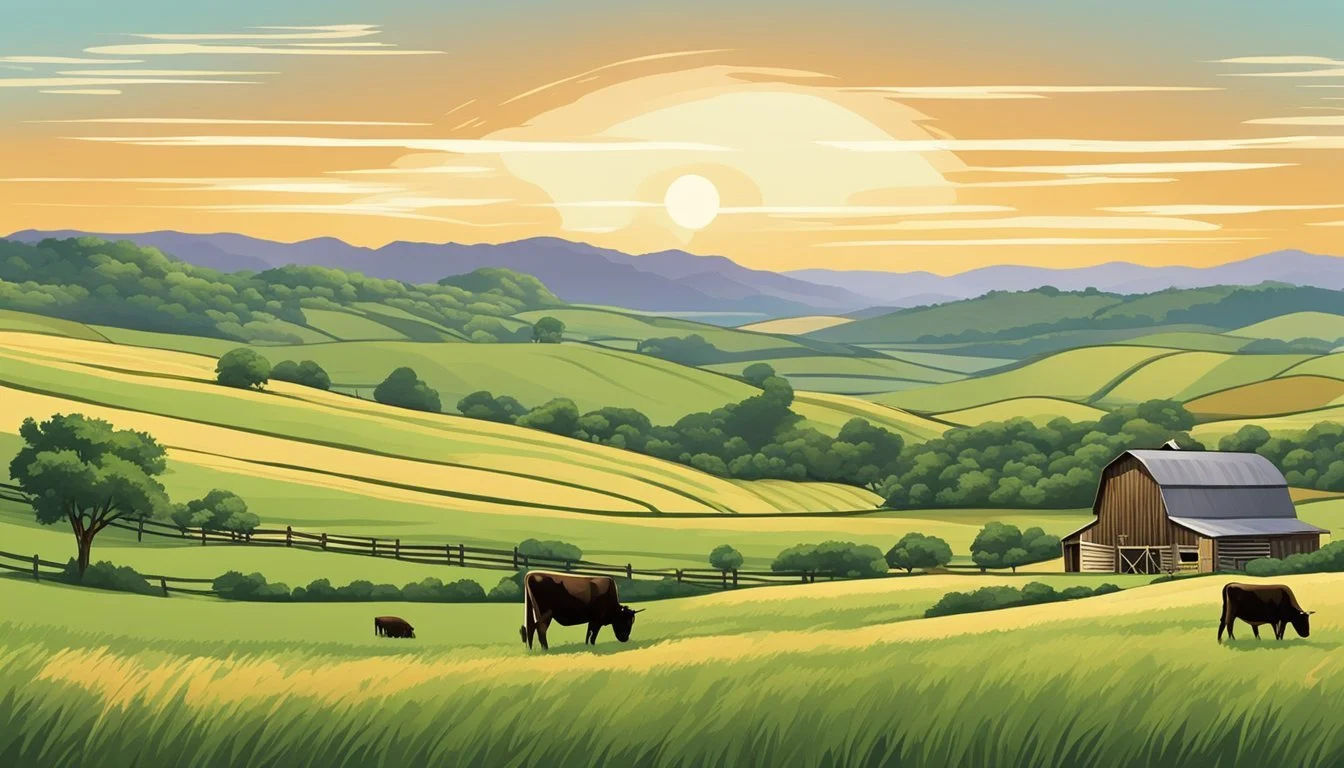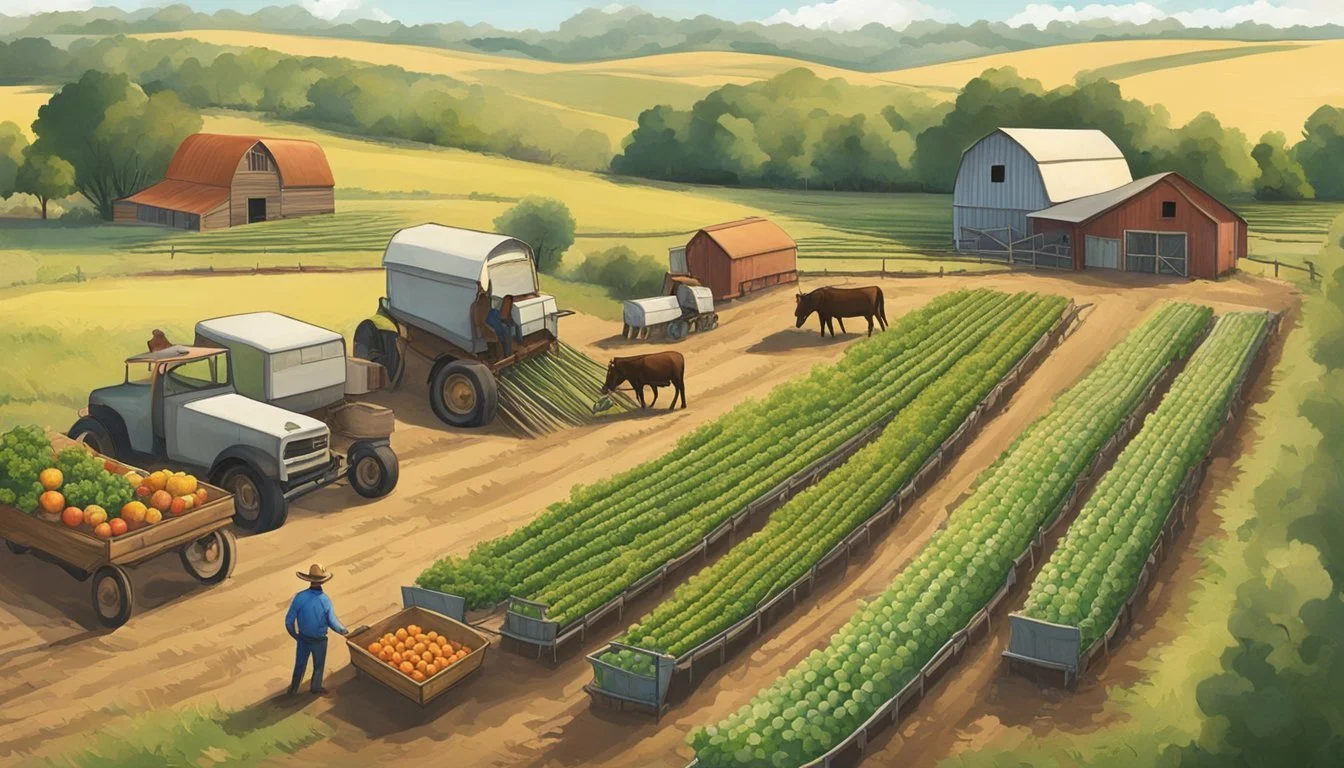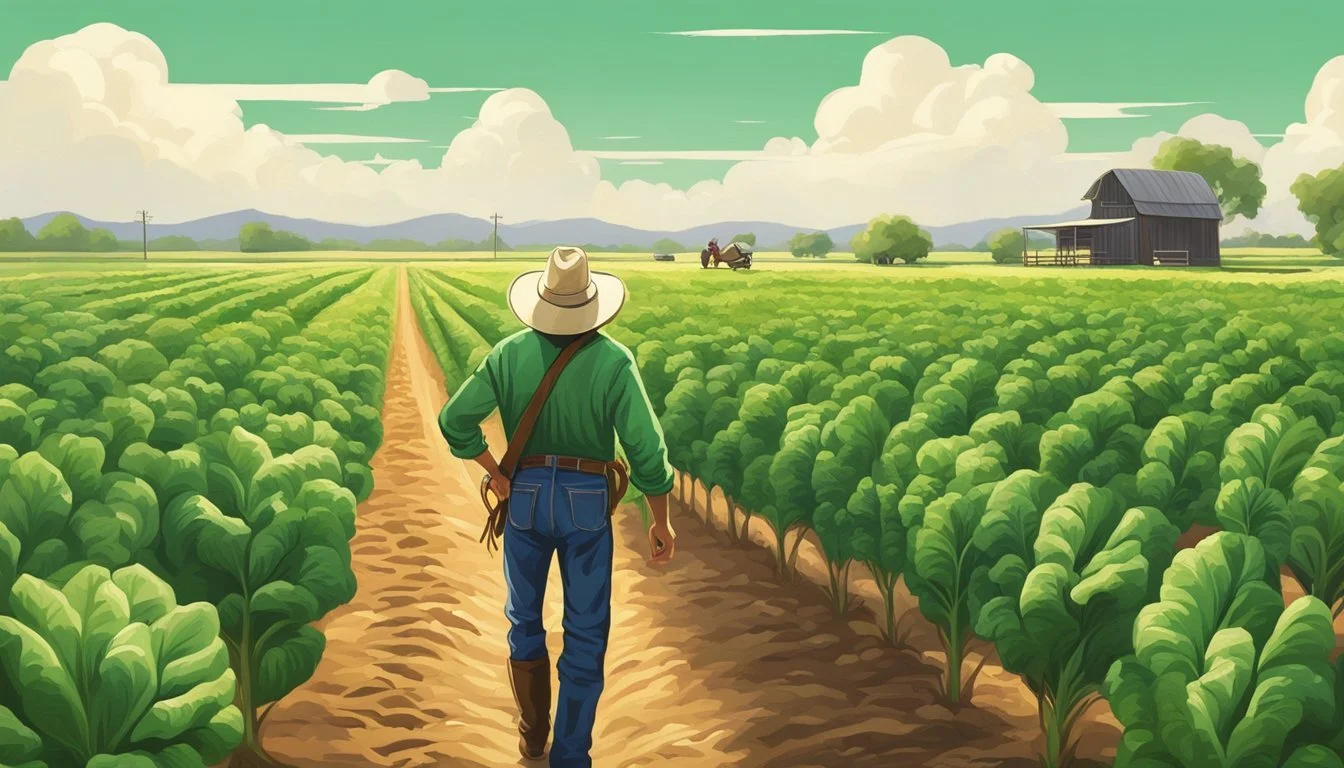The Texas Cowboy's Guide to Farm-to-Table Eating
Embracing Sustainable Agriculture
In the heart of Texas, the iconic cowboy is not only a cultural symbol but also plays a crucial role in shaping the state's approach to agriculture and local food systems. Embracing the farm-to-table philosophy, Texas agriculture is experiencing a renaissance where the time-honored values of self-reliance and stewardship of the land align with modern sustainable eating practices. Cowboys and local producers alike are championing the farm-to-table movement, ensuring that their tables are laden with fresh, locally-sourced produce, meat, and dairy products. This convergence of tradition and trend exemplifies a commitment to quality and community that’s as robust as Texas itself.
The farm-to-table concept in Texas is steeped in a tradition of freshness and quality, grounded in a firm understanding of the land and its bounty. As stewards of the land, Texas cowboys and farmers value the connection between the food they raise and the health of the local community. They take pride in the ethical treatment of animals and the responsible tilling of the earth, which results in nutrient-rich produce that embodies the taste of Texas. These agricultural practices not only honor the heritage of the cowboy but also underpin a thriving local economy that farmers and consumers benefit from in equal measure.
Traditionally, the cowboy's diet was necessarily pragmatic, largely influenced by the long cattle drives and the need for sustaining foods that could withstand the journey. Today, these historical roots have evolved into a culture that deeply appreciates the relationship between the land, ranchers, farmers, and the end consumer. The farm-to-table restaurants across the state are a testament to this ethos, with many establishments sourcing upwards of 90% of their ingredients from local purveyors. Such partnerships between restaurants and local producers exemplify how the Texas farm-to-table movement breathes new life into the state's agricultural heritage, ensuring that the cowboy legacy endures, meeting the modern diner's desire for authenticity and sustainability on their plates.
History and Culture of Texas Cowboys
The diverse history and enduring culture of Texas cowboys remain central to the identity of the Lone Star State. Embodying the spirit of rugged individualism and traditional heritage, cowboy culture has evolved over centuries, influenced by Spanish vaqueros and the pioneering ranchers.
Origins of the Cowboy Tradition
The cowboy tradition in Texas has historical roots dating back to Spanish settlers in the 1700s. These settlers brought with them the practice of ranching and the vocation of the vaquero, the original cowboys. They were skilled in herding and managing cattle, a foundation upon which the cowboy ethos was to be built.
Vaqueros: Pioneers of cattle ranching and horsemanship.
Heritage: A blend of Spanish tradition with the needs of New World settlers.
Evolution of Cowboy Culture
Over time, cowboys transformed from laborers into iconic figures of American folklore. The cattle drives, notably from Texas to railheads in Kansas following the Civil War, marked the golden era of cowboys. Ranches like the King Ranch and the 6666 Ranch became institutions that further cemented the importance of the cowboy.
Cattle Drives: Vital economic activity and a testament to the tenacity of cowboys.
Iconography: Cowboy hats and rodeos, symbols of the cowboy legacy.
Ranching Heritage
Texas ranches played a significant role in shaping cowboy culture. These expansive properties necessitated a breed of ranchers and cowboys who could handle the vast herds and challenging environment. As a result, activities such as rodeos and cattle drives were not just part of the job but became deep-seated traditions that celebrated cowboy skills and the ranching way of life.
Ranching: Central to cowboy livelihood and Texas's economy.
Tradition: Rodeos and community events, enduring celebrations of ranching culture.
Basics of Farm-to-Table Eating
Farm-to-Table eating in Texas intertwines local agriculture's freshness and nutrition with the rich tapestry of Texan cuisine, emphasizing flavorful and nourishing dishes.
Importance of Locally Sourced Ingredients
Sourcing ingredients locally is paramount to the Farm-to-Table approach because it ensures freshness and peak nutrition. Fresh produce like tomatoes and chilies, which are staples in Texan cuisine, offer a more vibrant taste when they haven't traveled long distances. Local sourcing also supports Texas's agricultural economy, encouraging sustainable practices and fostering community connection. Restaurants and consumers prize ingredients such as:
Vegetables: Locally grown for their crisp texture and heightened flavor.
Herbs and Spices: Fresh cumin and pepper to infuse dishes with the bold flavors Texans love.
Introducing Farm-to-Table to Traditional Dishes
Incorporating Farm-to-Table principles into traditional Texan dishes means embracing simplicity and the natural tastes of quality ingredients. TexasRealFood plays a crucial role by connecting consumers with local farmers, bringing an array of fresh options to the forefront. For example, a classic Texan chili can be elevated by using locally sourced meats and chilies, providing a more nuanced and robust flavor profile that supermarket ingredients often lack. Main components include:
Tomatoes and Chilies: Essential for a rich, hearty base.
Proteins: Grass-fed beef or free-range chicken, contributing to a nourishing and satisfying meal.
In summary, the basics of Farm-to-Table eating in Texas focus on the utilization of locally sourced, fresh ingredients to create dishes that are both traditional in spirit and innovative in taste.
Livestock and Agriculture in Texas
Texas stands as a cornerstone of American livestock and agriculture, boasting a thriving cattle industry that is inextricably linked to the state's culture and economy. Central to this industry are practices that celebrate the state's rich rodeo heritage while also embracing sustainable methods to propel its agricultural legacy into the future.
Cattle and Rodeo Culture
In Texas, cattle herding and ranching are not merely occupations but are foundational to the state's identity. The image of the Texan cowboy, steeped in rodeo culture, is symbolic of the Lone Star State's deep-rooted connection to its livestock, particularly beef cattle. Rodeos are more than entertainment; they showcase the skill and ingenuity needed in everyday livestock management, from herding cattle to ensuring their health and welfare.
Key facts:
Texas is one of the largest producers of cattle and beef in the United States.
Rodeos, originating from cattle herding practices, have evolved into competitive sporting events, celebrating the cowboy's role in Texas history.
Sustainable Farming Practices
With the spotlight on sustainability, Texas agriculture is pioneering in water conservation techniques and innovative livestock management strategies. Ranchers are increasingly adopting practices that not only improve the efficiency of meat production but also contribute to the health of the land and the longevity of resources.
Initiatives include:
Rotational grazing: Enhances pasture longevity and reduces water usage.
Precision agriculture: Utilizes technology for effective resource management, ensuring optimal growth conditions for crops that sustain livestock.
Sustainability in Texas is a testament to an evolving industry where tradition and innovation converge to meet the demands of modern agriculture. With a steady hand on preserving natural resources and a keen eye on market trends, Texas demonstrates that livestock and agriculture can flourish through a balance of respect for the past and adaptation for the future.
Iconic Texas Dishes
Texas cuisine reflects a rich tapestry of culinary heritage, marked by the hearty fare beloved by cowboys. It is characterized by robust flavors, traditional slow cooking methods, and a delectable array of spices and ingredients that embody the spirit of the Lone Star State.
Cowboy Stew and Chili
Cowboy Stew often stirs the appetite with its savory mix of ground beef, diced tomatoes, pinto beans, and spices. This one-pot meal, layered with flavor, reflects the practical, filling, and nutritious requirements of a cowboy's day.
Chili, particularly chili con carne, stands as an iconic Texas dish. Its core ingredients include tender slow-cooked beef, a rich beef broth, and a signature blend of Tex-Mex spices. Sour cream often tops this spicy favorite, adding a cooling contrast to its piquant warmth.
Cooking Techniques and Equipment
Texas cooks have long favored the Dutch oven, a versatile pot that's perfect for slow cooking. It is well-suited for preparing dishes like cowboy stew and chili, as it evenly distributes heat and allows flavors to meld beautifully over time.
The cast-iron skillet is another staple of Texas cooking. It excellently sears meats, leaving a flavorful crust that is often sought after in dishes like chicken-fried steak. For outdoor cooking, Texans rely on this robust equipment, whether it's placed over an open flame or nestled in a bed of coals.
Slow Cookers also play a pivotal role in Texas cuisine. They afford ease in preparing rich, slow-cooked meals full of complex flavors. One can trust this kitchen workhorse to produce tender, fall-apart meats that are central to many of the state's comfort dishes.
Culinary Traditions and Innovations
The Texas cowboy's culinary repertoire is steeped in tradition yet dynamic, evolving to include modern tastes while respecting its rustic roots. These changes are most apparent in the state's farm-to-table movement, which emphasizes local produce, and meat from Texan ranchers.
Modern Twists on Traditional Flavors
Texan ranchers, guardians of the state's agricultural heritage, have embraced contemporary approaches to classic dishes. Smoked sausage and bacon, staples of cowboy cuisine, are now often found in inventive recipes that impart new, flavorful twists.
Ingredients Common in Modern Variations:
Bacon: Now infused with a range of flavors, from chili powder to maple.
Smoked Sausage: Enhanced with diverse woods for smoking, such as mesquite or hickory.
Chili Powder: Utilized in innovative rubs and marinades.
Beer: Texas craft beers are becoming a popular ingredient in batters and stews for added depth.
Garlic and Onion: Always a foundation in Texan cooking, they are now being roasted or caramelized for intensified flavor.
These ingredients are delicately balanced to honor the traditional palate while introducing subtle nuances that speak to a modern audience.
The Influence of Multicultural Cuisine
Texas's diverse cultural tapestry directly influences its ranch cuisine, introducing an amalgamation of flavors. The state's proximity to Mexico and the history of Native American tribes contribute significantly to this culinary melting pot.
Multicultural Elements:
Paprika and Cumin: Brought by various immigrant communities, these spices are now cornerstones in Texan cooking.
Variations of Garlic and Onion: Used in multiple cuisines, they form the base of many Texan dishes.
Chili Powder: Originally from Mexican gastronomy, it's critical to the iconic Texas chili.
By integrating these elements with local ingredients, Texas chefs create dishes that are a testament to the state's rich cultural inheritance, showcasing an array of flavors that are as expansive as the Texas landscape.
Conservation and the Cowboy
In aligning ranching heritage with environmental stewardship, contemporary cowboys are at the forefront of both protecting and nurturing the land they work. They embody a unique blend of traditional practices and sustainable innovation, ensuring the resilience of their livelihood and the health of the ecosystems they manage.
Protecting the Land and Livestock
Land stewardship is pivotal in the cowboy approach to ranch management. They maintain the delicate balance between livestock needs and environmental health through:
Rotational grazing: Strategically moving livestock to prevent overgrazing and allow grasslands to recover.
Barbed wire usage: Implemented thoughtfully to delineate grazing areas while protecting wildlife habitats and water resources.
These practices are not only aimed at sustaining their livestock but are also crucial in preserving soil integrity and biodiversity.
Balancing Tradition with Ecological Awareness
Cowboys honor their ranching heritage while embracing sustainable practices. They show resilience in:
Integrating conservation efforts with established cowboy tradition.
Employing new techniques that reduce environmental impact, such as no-till farming to retain soil structure and moisture.
This balance furthers their ability to provide farm-to-table offerings that reflect an acute awareness of ecological implications and a responsibility to future generations.
The Future of Texas Cowboys and Agriculture
In the context of shifting market demands and technological advancements, the future of Texas cowboys and agriculture involves navigating through evolving challenges while preserving their heritage and promoting sustainability for future generations.
Challenges and Opportunities
Texas cowboys face a future that requires balancing tradition with innovation. As they adapt to technological advancements, such as livestock rotation and scientific approaches to soil health, they are poised to lead the charge in environmental stewardship. Community involvement is key, with ranchers like Frates Seeligson showing leadership through sustainable practices that benefit both the land and the livestock.
Innovation in Farming Practices:
Livestock rotation
Soil restoration
Technological Advancements:
Smart agriculture tools
Data-driven decision making
Maintaining cowboy ethics, such as hard work and integrity, ensures that the essence of the cowboy spirit remains intact amidst these changes. Education plays a crucial role in equipping future generations with the skills and knowledge to continue this legacy.
Continuing the Legacy
The Texas cowboy's heritage is not only about the iconic image of riding horses and tending cattle, but also about adapting to the future. By incorporating modern agricultural practices and engaging in community education, they are securing a place for the cowboy lifestyle in the face of changing environmental and market conditions.
Leadership and Community:
Educational outreach
Support for local agriculture
Securing the Future for New Generations:
Mentorship programs
Emphasis on sustainable methods
With a confident outlook, Texas cowboys are navigating these changes while remaining true to their history and looking ahead to a future that honors their past while innovating for sustainability and growth.







